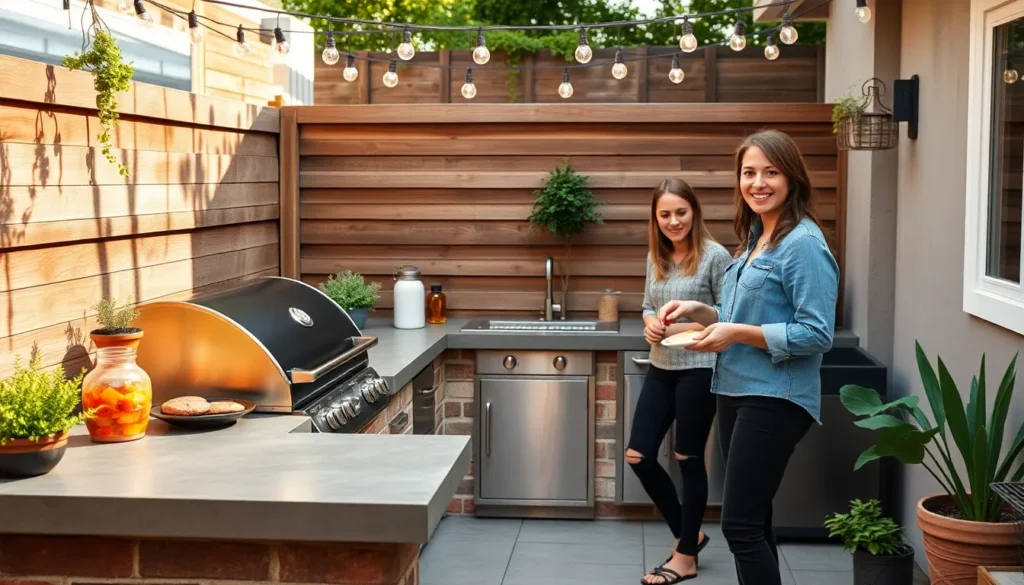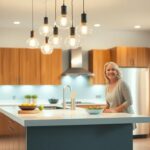We’ve all dreamed of creating the perfect outdoor cooking space but felt limited by our compact backyard or patio. The good news? You don’t need acres of space to build an incredible outdoor kitchen that’ll transform your entertaining game and boost your home’s value.
Small outdoor kitchens pack maximum functionality into minimal square footage. With smart design choices and creative answers we’ll share today you can create a cooking paradise that rivals any indoor kitchen. From portable prep stations to built-in grills that maximize every inch these ideas prove size doesn’t matter when it comes to outdoor culinary excellence.
Whether you’re working with a tiny balcony or a cozy corner of your yard we’ll show you how to create an outdoor kitchen that’s both practical and stunning. Get ready to discover space-saving answers that’ll have you cooking and entertaining outdoors year-round.
Compact Grill Station Designs for Maximum Functionality
Strategic grill station placement transforms even the tiniest outdoor spaces into fully functional cooking areas. We’ve compiled the most effective compact designs that deliver restaurant-quality results without overwhelming your patio or backyard.
Built-In Grill with Side Prep Space
Built-in grills create permanent cooking stations that maximize every inch of available space. We recommend installing a 30-inch grill with flanking prep counters that extend 18-24 inches on each side, providing adequate workspace for food preparation and plating.
Smart storage answers underneath the grill include pullout drawers for utensils, spice racks, and propane tank compartments. Concrete countertops offer durability and heat resistance while maintaining a sleek appearance that complements any outdoor design aesthetic.
Integrated cutting boards that slide over sections of the prep area double your workspace when needed. We suggest incorporating a small sink into one side counter to create a complete outdoor cooking triangle within a 6-foot linear space.
Rolling Cart Grill Setup
Rolling grill carts provide ultimate flexibility for small outdoor kitchens that need multipurpose functionality. These mobile stations typically measure 48-60 inches wide and include built-in storage shelves, prep surfaces, and utensil hooks.
Stainless steel construction ensures weather resistance while maintaining easy mobility across various outdoor surfaces. We recommend models with locking wheels that secure the cart during cooking and prevent unwanted movement on uneven patios.
Fold-down side tables expand your prep space when cooking and collapse for compact storage when not in use. Premium rolling carts feature built-in ice buckets, paper towel holders, and gas tank storage that keeps everything organized within arm’s reach.
Corner Grill Station Layout
Corner installations maximize unused outdoor space while creating efficient cooking workflows. We position the grill at a 45-degree angle with prep counters extending along both adjoining walls, forming an L-shaped configuration.
This design typically requires only 5-6 feet of linear space along each wall while providing 30-40 square feet of total cooking and prep area. Overhead storage cabinets mounted on one wall keep dishes and cooking supplies protected from weather elements.
Built-in lighting underneath upper cabinets illuminates the entire cooking surface during evening entertaining. We recommend installing electrical outlets within easy reach to power small appliances like blenders or food processors that expand your outdoor cooking capabilities.
Space-Saving Storage Solutions for Outdoor Cooking
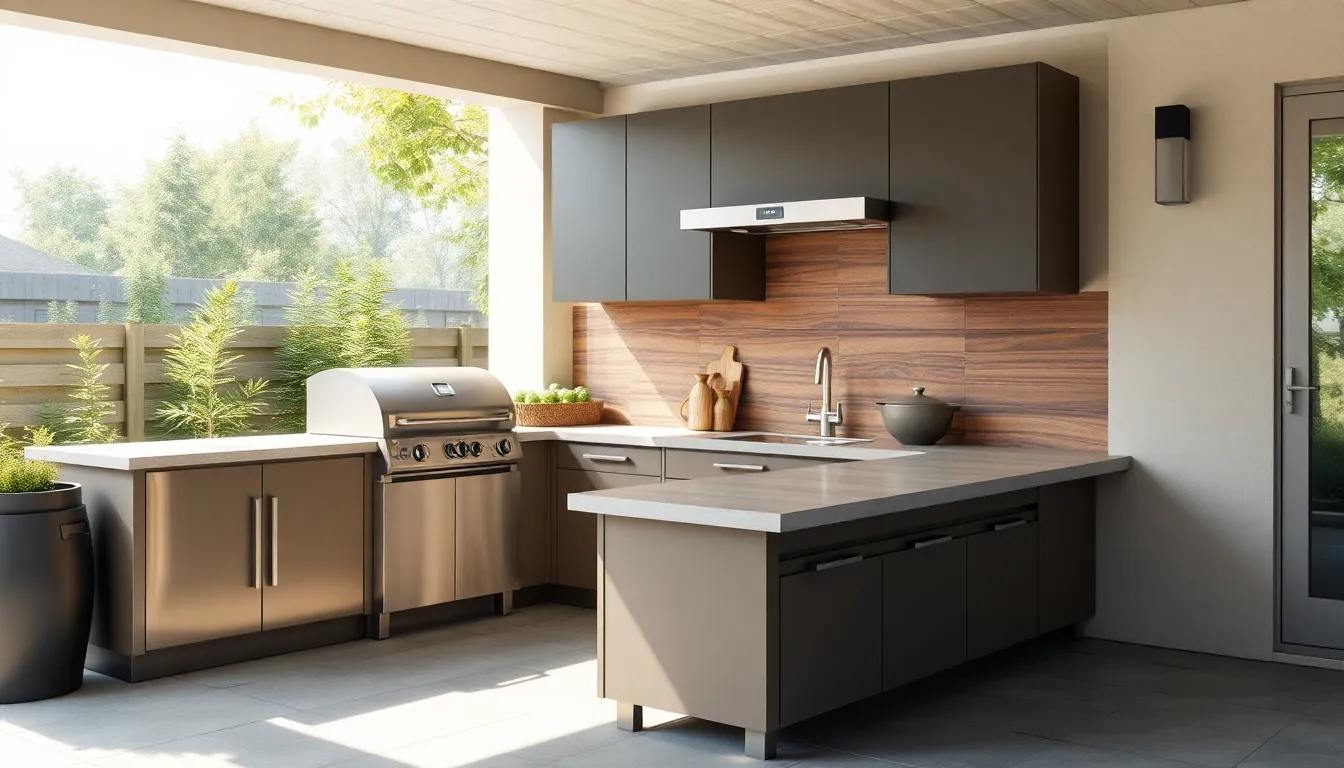
Smart storage answers transform cramped outdoor kitchens into organized, efficient cooking spaces. We’ve identified the most effective storage strategies that maximize every square inch while maintaining easy access to your essentials.
Vertical Wall-Mounted Cabinets
Wall-mounted cabinets use vertical space effectively while keeping cooking essentials organized without consuming precious floor area. These weatherproof storage units can match your outdoor kitchen’s aesthetic design while providing convenient access to utensils, spices, and small appliances. We recommend installing them at eye level for optimal accessibility and visual appeal.
Mounting options include stainless steel brackets for durability or decorative hardware that complements your outdoor décor. Professional installation ensures these cabinets withstand weather conditions while maintaining their functionality. Your countertop area remains clutter-free when vertical storage handles the overflow of cooking tools and supplies.
Under-Counter Storage Drawers
Drawers beneath counters or grills maximize storage capacity within a compact footprint while maintaining clean sight lines. These integrated storage answers hold grill accessories, cooking tools, and small appliances without disrupting your kitchen’s streamlined appearance. We suggest installing full-extension drawer slides for complete access to stored items.
Built-in compartments keep different categories of items separated and easily accessible during cooking sessions. Professional-grade drawer systems feature weather-resistant materials that protect contents from moisture and temperature fluctuations. Your workspace stays organized when every tool has its designated storage location beneath your prep surfaces.
Multi-Purpose Storage Benches
Storage benches serve dual functions by providing comfortable seating while offering hidden compartments for bulky items. These versatile pieces accommodate charcoal, outdoor dishware, cushions, and seasonal decorations within their spacious interiors. We recommend choosing benches with hydraulic hinges for smooth opening and closing operations.
Weather-resistant materials like teak or powder-coated aluminum ensure longevity in outdoor environments while maintaining their attractive appearance. Custom cushions add comfort for guests while protecting the storage compartment from the elements. Your outdoor kitchen gains both functionality and social space when storage benches create inviting seating areas.
Multi-Functional Island Ideas for Small Spaces
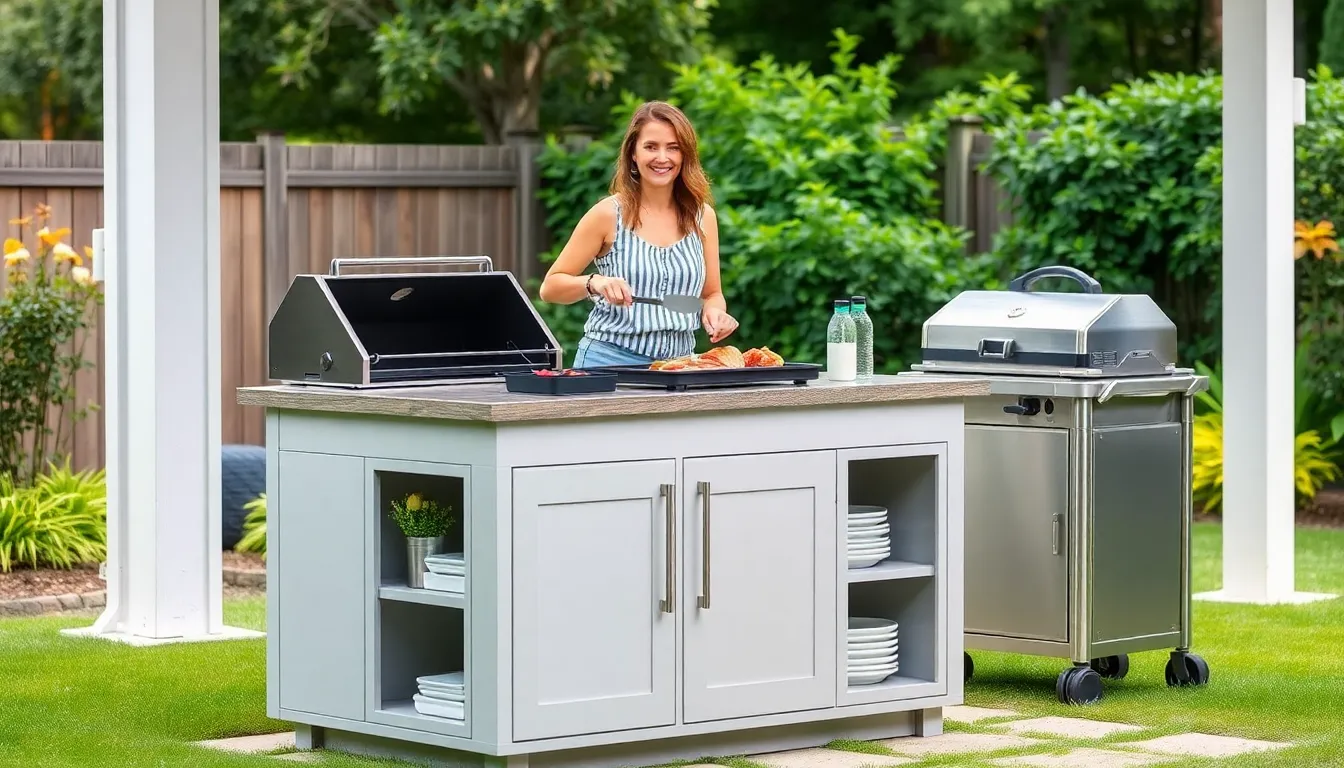
Smart island designs can transform any compact outdoor area into a fully functional cooking and entertainment hub. These versatile answers combine essential features like grills, storage, prep surfaces, and dining areas into single structures that maximize every square inch.
Portable Kitchen Cart Islands
Rolling cart islands offer incredible flexibility for small outdoor spaces where permanent installations aren’t practical. These mobile units can be positioned exactly where you need them during cooking sessions and stored away when not in use.
Key Features:
- Built-in storage compartments for utensils and supplies
- Wheels or casters for easy movement
- Collapsible surfaces that expand when needed
- Weather-resistant materials for outdoor durability
We recommend choosing carts with stainless steel tops for easy cleaning and longevity. Many models include built-in bottle openers, towel bars, and even small refrigeration units. The mobility factor means you can adapt your cooking setup based on wind direction, sun position, or guest seating arrangements.
Built-In Island with Dining Counter
Fixed islands with attached dining counters create the ultimate outdoor entertainment hub by combining cooking and socializing spaces. This configuration transforms your outdoor kitchen into a natural gathering spot where guests can interact with the cook.
Essential Components:
- Central cooking area with grill integration
- Extended counter space for food prep
- Raised dining section with bar stool seating
- Integrated storage underneath
The dining counter should extend at least 12 inches beyond the cooking surface to provide comfortable seating space. We suggest incorporating electrical outlets for small appliances and ambient lighting for evening use. This setup works particularly well for entertaining because it keeps conversations flowing while meals are being prepared.
L-Shaped Island Configurations
L-shaped islands efficiently use corner spaces while providing maximum functionality in compact areas. This layout creates distinct zones for different activities while maintaining an open feel that doesn’t overwhelm small outdoor spaces.
Zone Distribution:
- Short leg: Grill and primary cooking area
- Long leg: Prep space and sink integration
- Corner: Storage and small appliance housing
- Exterior: Casual seating or serving space
The corner section naturally becomes a storage powerhouse where you can install cabinets, drawers, or even a small refrigerator. This configuration allows multiple people to work simultaneously without crowding. We find that positioning the grill at the corner junction creates the most efficient workflow for food preparation and serving.
Creative Counter Space Solutions
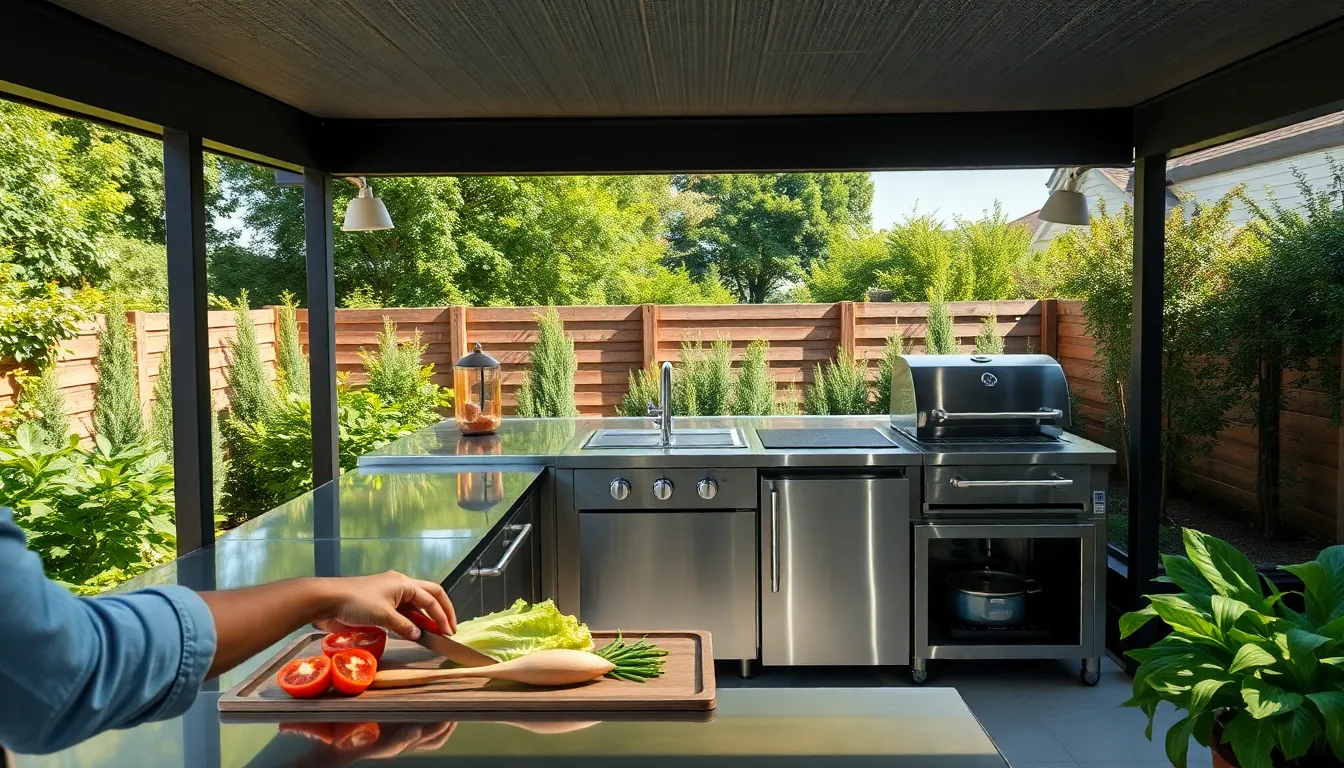
When space is at a premium, maximizing every square inch of your outdoor kitchen becomes crucial. These innovative counter answers help expand your workspace without permanently increasing your kitchen’s footprint.
Fold-Down Prep Tables
Fold-down prep tables transform empty wall space into functional work areas that disappear when you don’t need them. We recommend installing these wall-mounted surfaces near your grill or main prep zone for maximum convenience. They’re perfect for chopping vegetables, assembling dishes, or staging ingredients before cooking.
The beauty of these tables lies in their flexibility. Mount them at the ideal height for your cooking style, and fold them flat against the wall when you’re entertaining guests or need more room to move around. Many homeowners install multiple fold-down tables at different heights to create temporary prep stations throughout their outdoor kitchen.
Look for models with locking mechanisms to ensure stability during food preparation. Stainless steel or weather-resistant wood options work best for outdoor environments, providing durability while maintaining an attractive appearance.
Tiered Counter Systems
Tiered counters create multiple levels of workspace by building up rather than out, making them ideal for compact outdoor kitchens. We design these systems with a lower counter for food preparation and an elevated tier for serving or storing frequently used items like condiments and utensils.
This vertical approach maximizes your operational flow while keeping your kitchen’s footprint small. Place your main prep work on the lower level while using the upper tier for plating, serving, or keeping clean dishes within easy reach.
Consider incorporating different materials for each tier to define their purposes. Use butcher block for the prep level and granite or concrete for the serving tier. This not only looks sophisticated but also provides the right surface for each task.
Extension Counter Attachments
Extension counter attachments give you the flexibility to expand your workspace on demand through sliding or hinged surfaces that connect to existing kitchen units. We find these particularly useful for entertaining, as they provide extra prep space when you’re cooking for larger groups but retract to maintain your kitchen’s compact size.
These attachments work especially well with straight-line and L-shaped layouts, where you can add temporary workspace without disrupting traffic flow. Install them on the sides of your grill station or prep area where they’ll be most useful during cooking.
Many extension counters feature locking mechanisms to ensure stability when extended and smooth operation when retracting. Choose materials that match your existing countertops for a seamless look, or create visual interest with contrasting surfaces that highlight their functional versatility.
Budget-Friendly DIY Small Outdoor Kitchen Projects
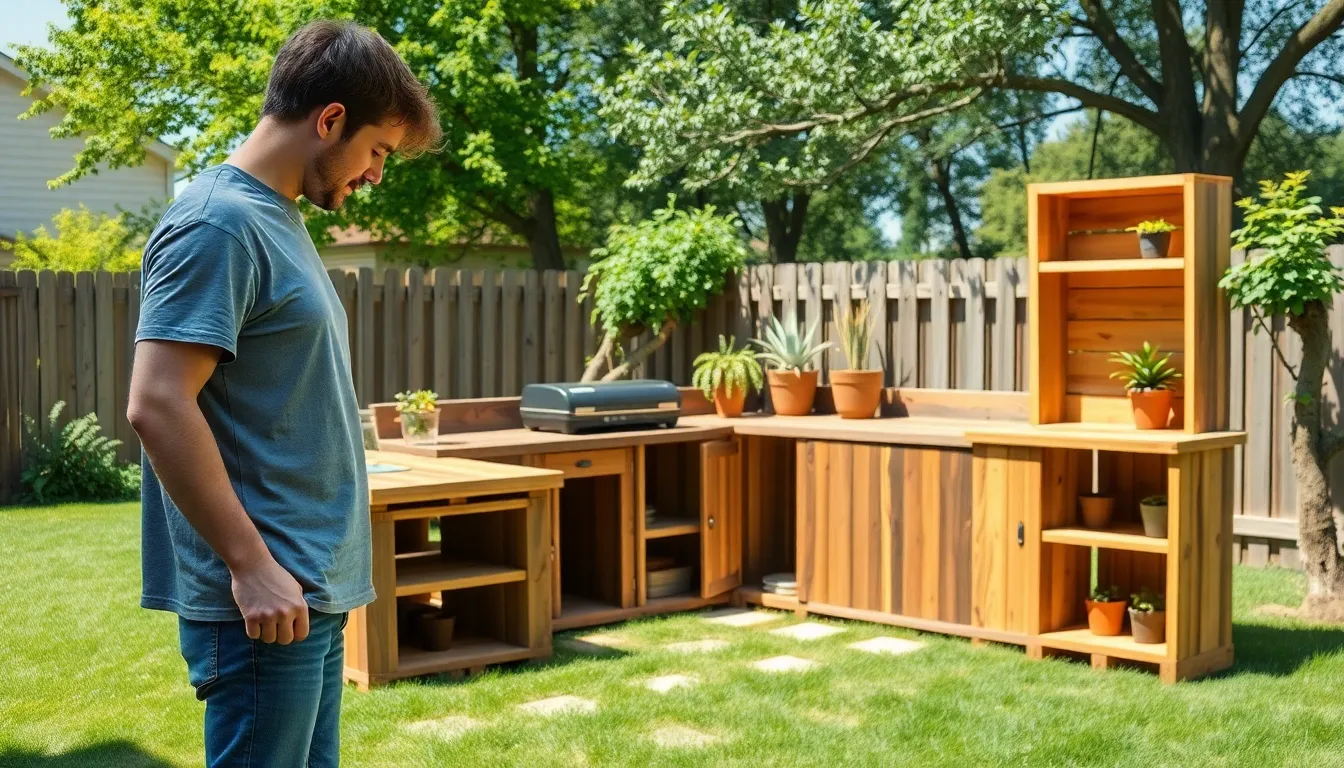
Creating your dream outdoor kitchen doesn’t require a massive budget or professional contractors. We’ve gathered the most cost-effective DIY projects that deliver maximum functionality while keeping expenses minimal.
Pallet Wood Kitchen Structures
Pallet wood transforms into stunning outdoor kitchen components for just a fraction of traditional materials’ cost. We recommend sanding down reclaimed pallets and applying weather-resistant stain to create custom counters, storage cabinets, and open shelving units. These structures add rustic charm while fitting perfectly into any compact space design.
Building with pallets allows complete customization to match your exact cooking needs and available area. You can stack multiple pallets vertically for tall storage towers or arrange them horizontally for extended counter space. The natural wood grain provides beautiful texture that complements both modern and traditional outdoor aesthetics.
Sealing your pallet wood structures with marine-grade polyurethane ensures durability against rain, sun, and temperature changes. This protective coating extends the lifespan of your investment while maintaining the wood’s natural appeal throughout multiple seasons.
Concrete Block Counter Builds
Concrete blocks create incredibly sturdy foundations for outdoor kitchen counters at minimal expense. We stack standard concrete blocks to form the base structure, then top them with poured concrete countertops or decorative tiles for a polished finish. This technique requires basic tools and delivers professional-looking results.
Shaping your concrete block foundation allows for creative layouts including straight runs, L-shaped configurations, or even curved designs. The blocks’ modular nature makes it easy to adjust dimensions during construction without complex cutting or fitting processes. You can incorporate spaces for built-in grills, storage compartments, or utility connections.
Finishing options for concrete block counters range from smooth troweled surfaces to textured stamps that mimic natural stone. We suggest adding integral color to the concrete mix for consistent appearance or applying acid stains for unique mottled patterns that enhance the outdoor kitchen’s visual appeal.
Repurposed Furniture Kitchen Setups
Converting old furniture into functional outdoor kitchen stations reduces waste while creating unique cooking spaces. We transform vintage dressers, cabinets, and rolling carts by adding weather-resistant finishes and modifying surfaces to accommodate appliances and prep areas. These pieces bring character and functionality to any outdoor cooking setup.
Modifying furniture for outdoor use requires strategic planning to ensure proper ventilation and heat resistance. You can cut openings in dresser tops to accommodate portable grills or add stainless steel inserts for food prep surfaces. Installing casters on heavy pieces creates mobile kitchen stations that adapt to different entertaining needs.
Protecting repurposed furniture with marine-grade paint or sealers prevents moisture damage and extends usability. We recommend choosing pieces with solid wood construction rather than particle board, as they better withstand outdoor conditions and modification processes while maintaining structural integrity.
Efficient Appliance Selection for Compact Areas
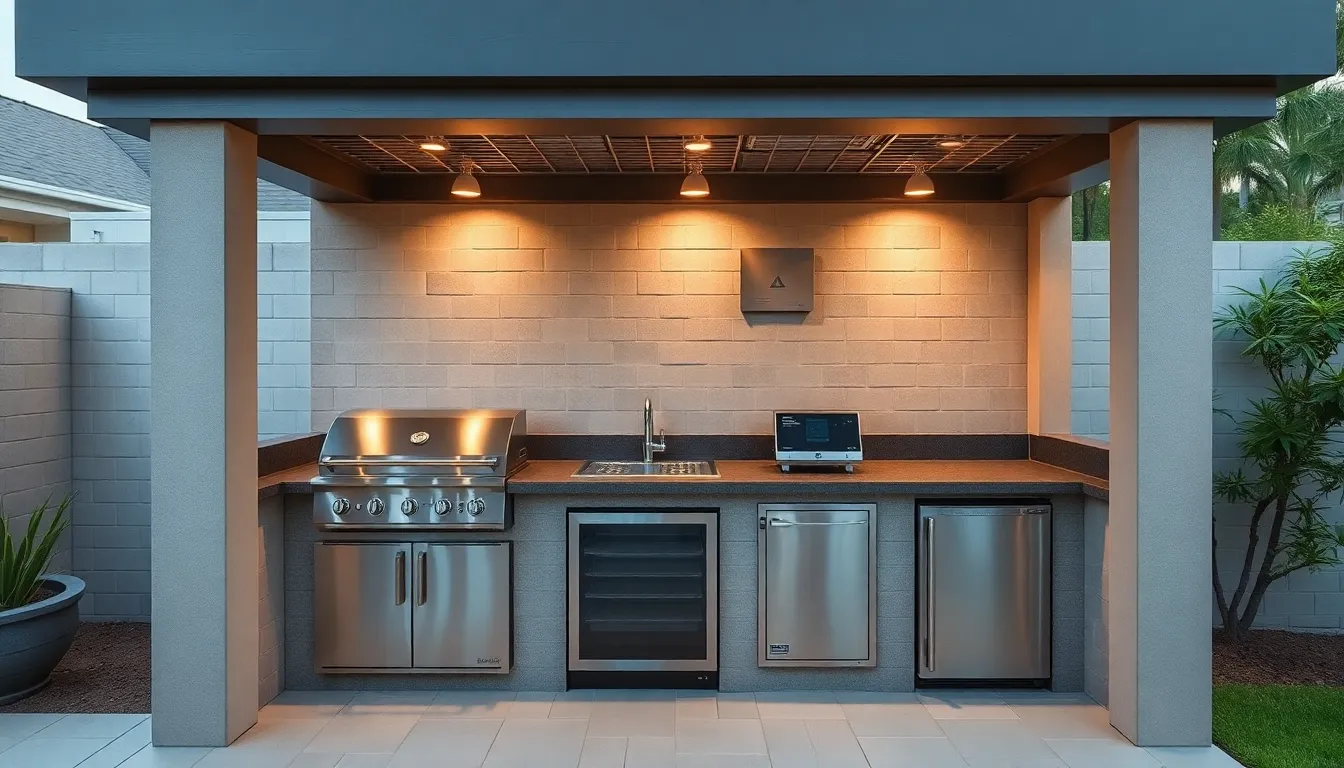
Smart appliance choices form the foundation of any successful small outdoor kitchen design. We’ll focus on selecting appliances that maximize functionality while minimizing your outdoor space footprint.
Space-Conscious Grill Choices
Compact built-in grills deliver exceptional cooking performance without overwhelming your limited outdoor space. These streamlined units integrate seamlessly into your countertop design while providing all the grilling capability you need for outdoor entertaining.
Grill stations with side burners combine multiple cooking functions into one consolidated unit. This smart approach eliminates the need for separate appliances and creates an efficient cooking zone that fits perfectly in tight spaces.
Grill islands work exceptionally well when integrated into small countertop areas. These setups provide easy access to your cooking surface while maintaining clean lines that won’t crowd your outdoor kitchen layout.
Compact Refrigeration Options
Under-counter outdoor refrigerators keep beverages and perishables within arm’s reach without taking up valuable counter space. These compact models fit seamlessly into your cabinetry design and maintain your kitchen’s sleek aesthetic.
Small outdoor fridges offer the perfect storage solution for compact areas. We recommend choosing models that complement your overall design while providing adequate refrigeration for your outdoor cooking needs.
Built-in refrigeration units integrate directly into your counter space or cabinetry. These options eliminate the bulky appearance of standalone units while maximizing your available workspace.
Multi-Use Cooking Appliances
Combination cooktops with grilling surfaces reduce the number of standalone units you need in your small outdoor kitchen. These versatile appliances provide multiple cooking methods in one compact footprint.
Grills with integrated side burners offer excellent versatility for outdoor cooking. You can grill your main course while simultaneously preparing side dishes or sauces on the same unit.
Pull-out drawers and built-in storage answers complement your multi-use appliances by maximizing utility in confined spaces. These integrated features eliminate clutter while keeping essential cooking tools and supplies organized and accessible.
Smart Layout Designs for Tiny Outdoor Kitchens
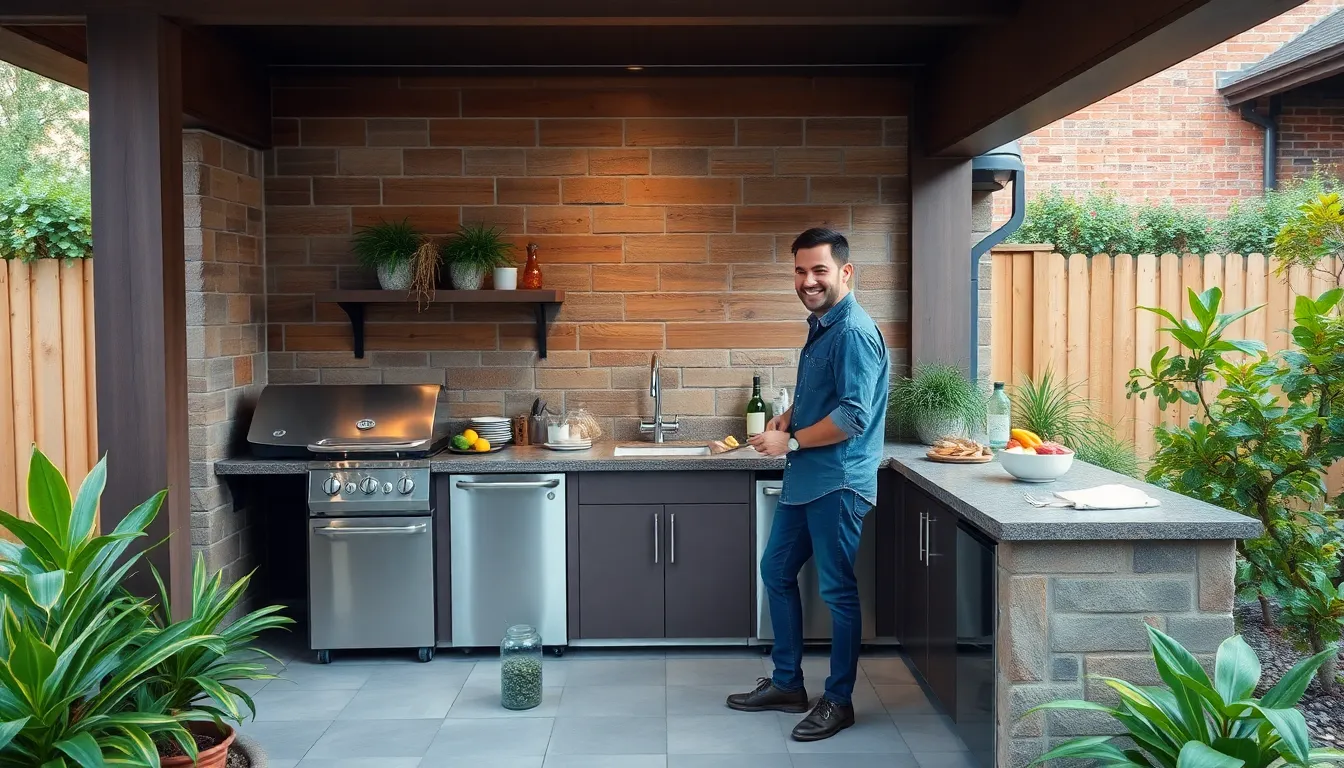
Smart layout planning transforms even the smallest outdoor spaces into highly functional cooking areas. We’ll explore three proven layout designs that maximize every square inch while maintaining optimal workflow.
Galley-Style Kitchen Arrangements
Galley style outdoor kitchens position appliances and countertops along two parallel walls or a single wall in narrow spaces. This linear arrangement creates a streamlined workflow that keeps everything within arm’s reach, making it perfect for long, narrow patios or deck areas.
These layouts excel in space efficiency by utilizing the natural corridor shape of many outdoor areas. We recommend incorporating a grill, prep space, and storage along the parallel counters to maintain the clean, minimalist aesthetic while maximizing functionality.
Installation becomes simpler with galley designs since plumbing and electrical lines can run along straight paths. The compact footprint leaves more open space for dining and entertaining areas in your backyard.
U-Shaped Compact Layouts
U shaped outdoor kitchens wrap around three sides of a designated cooking area, creating the maximum amount of countertop and storage space possible. This configuration allows multiple appliances like grills, sinks, and refrigerators to integrate seamlessly while establishing distinct work zones and dining areas.
Smart appliance selection makes U shaped layouts feasible even in smaller outdoor spaces. Compact built-in units and strategic placement create an efficient workflow triangle that promotes smooth meal preparation and cooking processes.
Semi enclosed cooking zones emerge naturally from this design, helping define the outdoor kitchen space while maintaining the open air feeling. The wraparound counter provides ample prep space and can accommodate bar stools for casual dining.
Single-Wall Kitchen Designs
Single wall outdoor kitchens position all essential elements along one straight counter, making them ideal for very small or narrow spaces where width limitations exist. This layout keeps everything accessible while simplifying installation requirements and utility connections.
Clean lines and functional design characterize single wall arrangements, providing a sleek appearance that doesn’t overwhelm small backyard areas. Built-in appliances and stylish finishes enhance both usability and visual appeal without consuming excessive square footage.
Customization options remain extensive even though the compact footprint, allowing for personalized storage answers and appliance configurations. The straightforward design makes single wall kitchens perfect for homeowners who want essential outdoor cooking capabilities without complex layouts.
Weather-Resistant Materials for Small Outdoor Kitchens
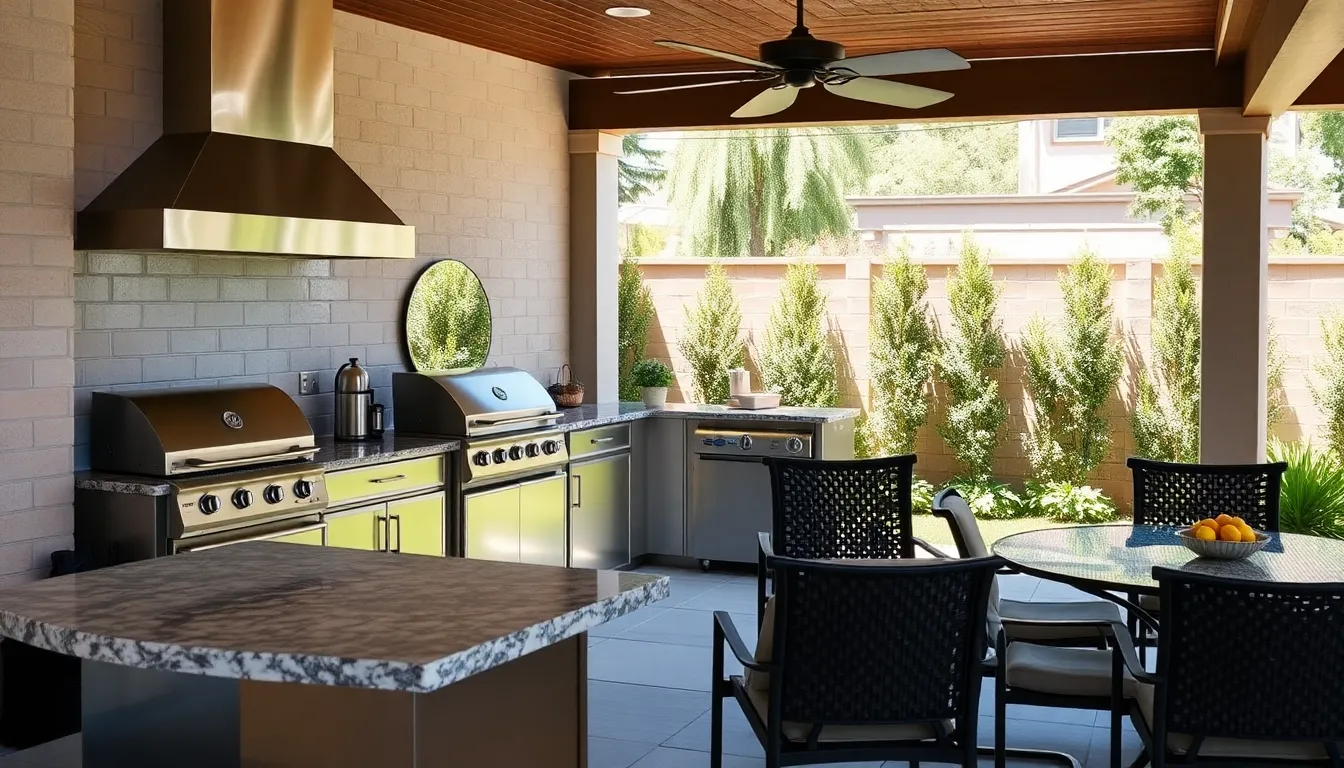
Selecting the right materials can make or break your outdoor kitchen’s longevity and performance. We’ve compiled the most proven material choices that’ll withstand harsh weather conditions while maintaining their functionality and appearance.
Durable Countertop Materials
Granite countertops deliver exceptional heat resistance and durability that outdoor kitchens demand. Temperature fluctuations won’t cause cracking or fading, making granite an investment that pays off over years of use. We recommend sealing granite annually to maintain its weather resistance.
Concrete surfaces offer unlimited customization options for your small outdoor kitchen design. Professional sealing prevents stains and weather damage while allowing you to create custom shapes that fit your exact space requirements. Concrete countertops can be formed on site to maximize every inch of your available area.
Porcelain tile installations resist UV rays and temperature extremes better than most materials. These tiles won’t fade under constant sun exposure and handle freeze-thaw cycles without cracking. We find porcelain particularly effective for outdoor prep areas where durability meets easy maintenance.
Stainless steel prep surfaces excel around grill stations and high-use cooking areas. Heat damage isn’t a concern with stainless steel, though occasional cleaning maintains its signature shine. This material integrates seamlessly with outdoor appliances while providing a professional kitchen aesthetic.
Weather-Proof Cabinet Options
Marine grade polymer cabinets represent the gold standard for outdoor kitchen storage. Water damage and UV exposure can’t penetrate these synthetic materials, making them practically maintenance free. We’ve seen these cabinets perform flawlessly in coastal environments where salt air destroys other materials.
Stainless steel cabinet systems provide unmatched rust resistance and easy cleaning capabilities. Professional outdoor kitchens rely on stainless steel because it handles moisture exposure without warping or deteriorating. These cabinets maintain their appearance and function even in high humidity climates.
Powder coated aluminum options deliver lightweight construction without sacrificing durability. Rust formation isn’t possible with aluminum, and powder coating adds an extra protective layer against moisture and scratches. We recommend aluminum cabinets for covered outdoor areas where weight considerations matter.
Rust-Resistant Hardware Choices
Stainless steel hardware offers the most reliable protection against outdoor corrosion and rust. Hinges, handles, and drawer slides made from stainless steel maintain smooth operation through years of weather exposure. We always specify stainless steel hardware for coastal installations where salt air accelerates corrosion.
Brass and bronze hardware develops attractive patina over time while resisting rust formation. These metals weather naturally and actually improve in appearance as they age. Traditional outdoor kitchen designs benefit from the warm tones that brass and bronze provide.
Powder coated metal hardware creates a protective barrier against moisture and oxidation. The coating process seals the underlying metal from direct contact with water and humidity. We find powder coated options particularly effective when color coordination with cabinet finishes is important.
Lighting and Electrical Considerations for Compact Spaces
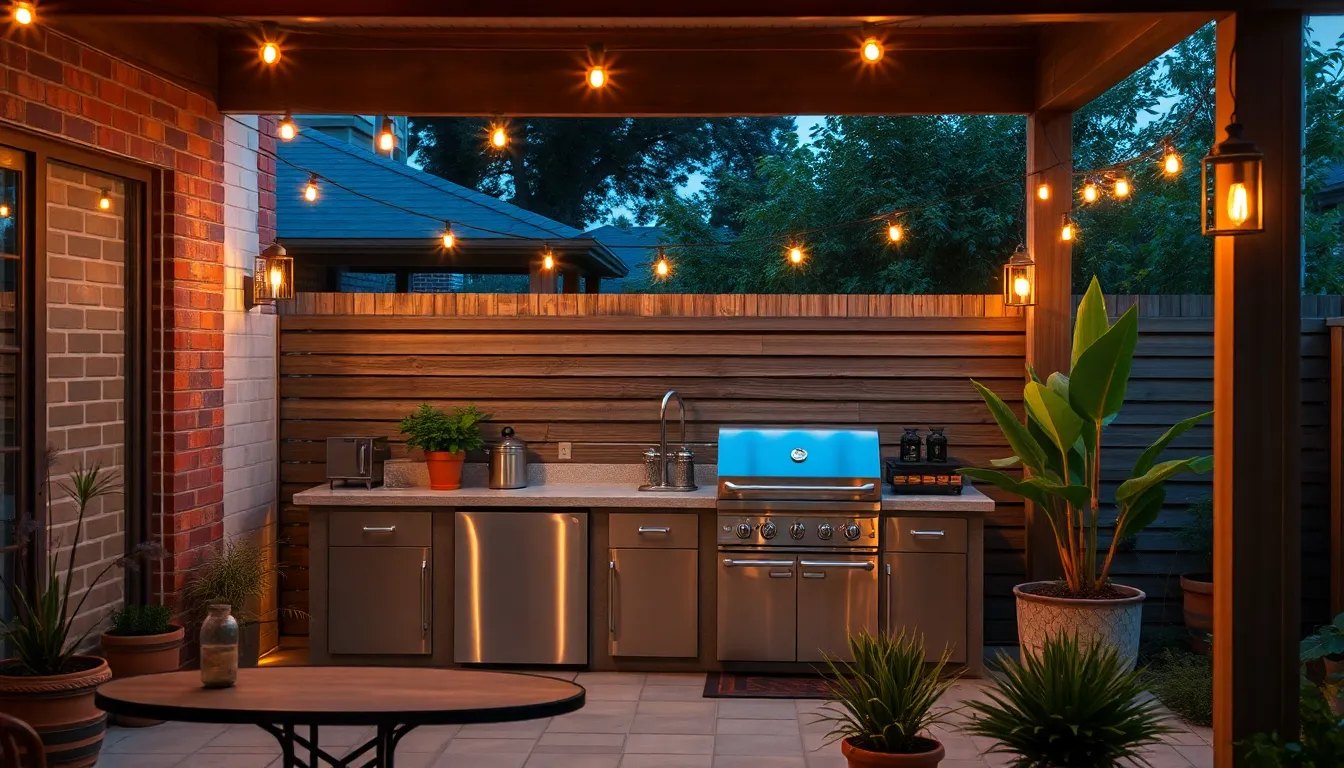
Proper lighting and electrical planning transform small outdoor kitchens into functional cooking spaces that extend your entertaining well into the evening hours. We’ll explore essential lighting answers and safety measures that maximize both visibility and ambiance in compact outdoor cooking areas.
Task Lighting Answers
Task lighting ensures clear visibility for safe food preparation and cooking in your compact outdoor kitchen. Under-cabinet LED strips provide direct illumination on countertops without consuming valuable overhead space, making them perfect for small layouts. Adjustable spotlights mounted above key work areas deliver focused lighting exactly where you need it most.
Position these lights strategically over your grill, prep surfaces, and sink areas to eliminate shadows during cooking. Weather-resistant pendant lights offer another excellent option for illuminating cooking stations while adding visual interest to your outdoor space. We recommend choosing fixtures specifically designed for outdoor use to withstand rain, wind, and temperature fluctuations.
Dimmable LED options give you control over light intensity based on different cooking tasks and times of day. Installing multiple light sources prevents dark spots and ensures even coverage across your entire workspace.
Ambient Lighting Options
String lights create a warm, inviting atmosphere in compact outdoor kitchens without requiring bulky installations or extensive electrical work. These versatile fixtures can be draped along fence lines, wrapped around pergola posts, or hung overhead to define your cooking space. Solar-powered garden lights positioned around your kitchen perimeter provide eco-friendly illumination that automatically activates at dusk.
Recessed lighting installed in overhead covers, pergolas, or pavilions offers broad, diffused illumination that enhances the overall ambiance. We suggest incorporating multiple ambient lighting layers to create depth and visual interest in your small outdoor kitchen. Lanterns and decorative sconces mounted on walls or posts add character while providing supplemental lighting for dining and entertaining areas.
Battery-operated LED fixtures offer flexibility in placement without requiring additional electrical connections, making them ideal for renters or temporary setups.
Safe Electrical Installation Tips
Ground-fault circuit interrupters (GFCI) outlets prevent electrical shocks and are essential for any outdoor kitchen electrical installation. We recommend positioning all outlets and switches away from direct water exposure, including areas that receive rain or cooking splashes. Licensed electricians should handle all electrical installations to ensure proper grounding, code compliance, and weatherproof connections.
Choose weatherproof electrical fixtures and outlets rated for outdoor use to prevent moisture damage and safety hazards. Plan your electrical layout carefully to avoid overcrowding circuits and maintain clear workspace access around all electrical components. All wiring must be properly buried or protected in conduit to prevent damage from foot traffic or landscaping activities.
Install dedicated circuits for high-power appliances like grills and refrigerators to prevent overloading your electrical system. We suggest placing electrical panels in covered, accessible locations for easy maintenance while keeping them protected from the elements. Regular inspection of all electrical components helps identify potential issues before they become safety hazards.
Small Outdoor Kitchen Ideas for Different Settings
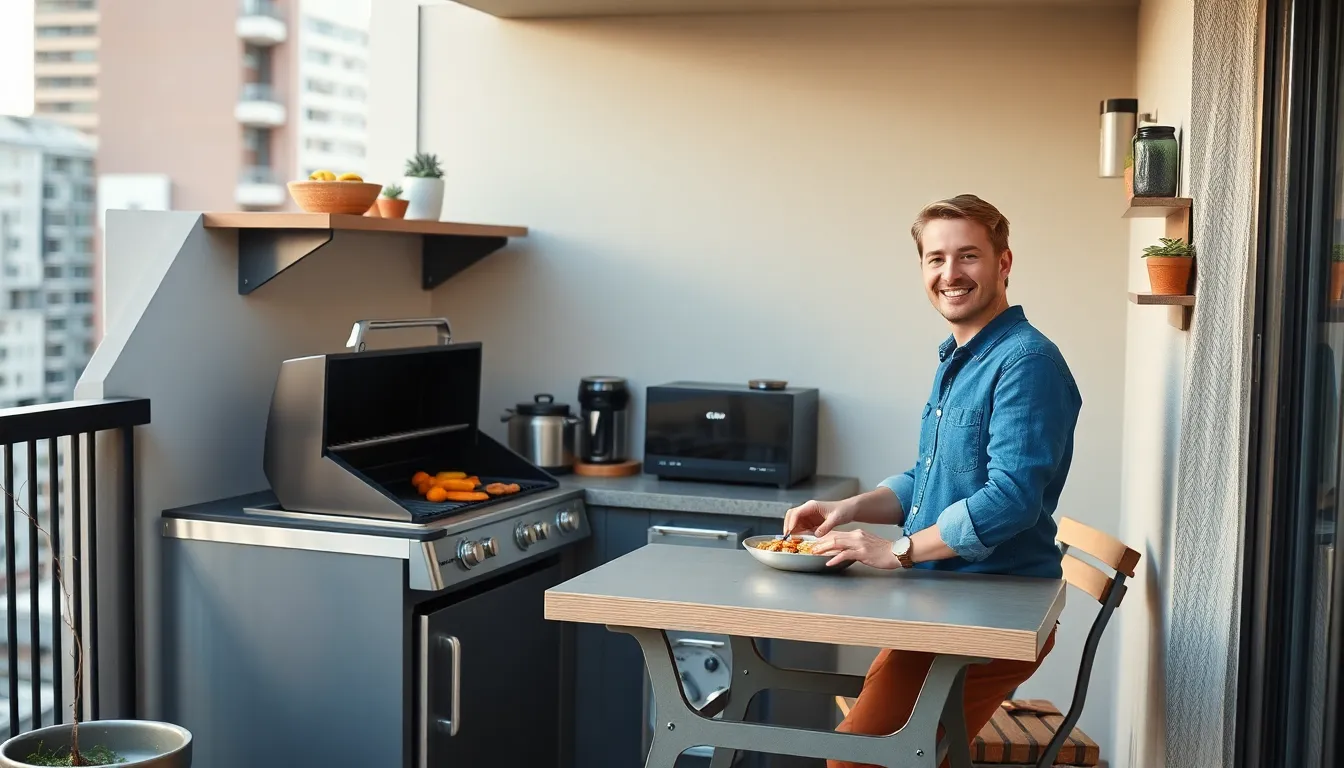
We’ll explore how different outdoor spaces require unique approaches to kitchen design, each offering distinct opportunities for creating functional cooking areas.
Apartment Balcony Kitchens
Balcony kitchens demand the most compact answers since space constraints are particularly challenging in apartment settings. We recommend focusing on portable cooktops and small grills that can be stored when not in use. Vertical storage becomes essential here, with wall mounted shelves and hanging racks maximizing every available inch.
Foldable counters offer ingenious answers for prep space, allowing you to extend your workspace during cooking sessions and fold it away afterward. Stainless steel appliances work exceptionally well on balconies because they resist weather elements and maintain a sleek appearance. Rolling carts serve dual purposes as both storage and mobile prep stations, giving you flexibility to rearrange your setup as needed.
Safety considerations become paramount on balconies, so we always recommend checking building regulations and ensuring proper ventilation for any cooking appliances. Compact designs that include a small grill, minimal counter space, and clever storage answers can transform even the smallest balcony into a functional outdoor cooking area.
Small Backyard Designs
Small backyards offer more flexibility than balconies while still requiring strategic planning to maximize functionality. L shaped layouts prove most popular because they use corner spaces effectively while providing ample countertop area for both prep work and serving. This configuration typically accommodates a grill, sink, and compact refrigerator while maintaining good workflow patterns.
Straight line layouts work perfectly for narrow yards, positioning all appliances and workspace along one side to create a streamlined cooking area. This linear arrangement keeps everything within easy reach while preserving open space for seating or dining areas. Built in grills with side burners become focal points in these designs, offering serious cooking capabilities without overwhelming the space.
U shaped layouts provide the most counter space and storage by wrapping around three sides, though they require careful planning in smaller backyards. We’ve found that incorporating drawer storage and pull out trash bins into these designs helps accommodate BBQ parties and regular outdoor cooking activities. Compact appliances and clever storage answers make even U shaped configurations work in surprisingly small spaces.
Patio Kitchen Configurations
Patio kitchens typically employ streamlined island or linear formats that integrate seamlessly with existing outdoor living spaces. We often design these configurations to include essential elements like grills, counter space, and storage while maintaining clean sight lines throughout the patio area.
Covered patio kitchens offer important advantages by providing weather protection and extending the cooking season. These designs allow for more permanent installations since appliances stay protected from the elements. Integration with seating areas becomes easier on patios, where we can create natural flow between cooking and dining zones.
Island configurations work particularly well on larger patios, creating central gathering points that help entertaining. Linear formats suit rectangular patios better, positioning the kitchen along one edge while preserving open space for furniture and activities. Smart storage answers and compact appliances ensure these patio kitchens deliver full functionality without requiring massive footprints.
Conclusion
Creating your dream outdoor kitchen doesn’t require a massive backyard or unlimited budget. We’ve shown you how smart design choices and creative answers can transform even the smallest spaces into functional cooking havens.
From portable grill stations to DIY projects using pallets and concrete blocks these ideas prove that size limitations shouldn’t stop you from enjoying outdoor cooking. The key lies in maximizing every square inch through multi-functional elements and efficient layouts.
Whether you’re working with a tiny balcony or a compact patio these strategies will help you build an outdoor kitchen that enhances your entertaining experience. Start small choose weather-resistant materials and focus on functionality – your perfect outdoor cooking space is closer than you think.
Frequently Asked Questions
Can I create a functional outdoor kitchen in a small space?
Yes, you can absolutely create a functional outdoor kitchen in small spaces like compact backyards or patios. Smart design choices, portable prep stations, built-in grills, and creative storage solutions help maximize functionality in minimal square footage. The key is choosing multi-functional elements and space-saving designs that optimize every inch of your outdoor area.
What are the best grill options for compact outdoor kitchens?
Built-in grills with side prep areas are ideal for small spaces as they maximize functionality while minimizing footprint. Rolling cart grill setups offer flexibility and mobility, while corner grill stations efficiently utilize unused space. Multi-use cooking appliances like combination grills with integrated side burners help reduce the number of standalone units needed.
How can I maximize storage in a small outdoor kitchen?
Utilize vertical wall-mounted cabinets, under-counter storage drawers, and multi-purpose storage benches. Pull-out drawers and built-in storage solutions keep cooking tools organized and accessible. Consider repurposing furniture and using creative solutions like tiered systems to make the most of available space while maintaining functionality and aesthetics.
What layout works best for tiny outdoor kitchens?
Three proven layouts work well: galley-style (two parallel walls), U-shaped (maximizes counter and storage space), and single-wall designs (all elements along one counter). Choose based on your space constraints and workflow preferences. Each layout emphasizes functionality while being suitable for different space configurations and installation requirements.
What materials are best for small outdoor kitchens?
Weather-resistant materials are crucial. For countertops, choose granite, concrete, or porcelain tile for heat resistance. Stainless steel surfaces offer professional aesthetics and easy maintenance. For cabinetry, marine-grade polymer and stainless steel resist moisture and UV exposure, while powder-coated aluminum provides lightweight durability with rust-resistant properties.
Can I build an outdoor kitchen on a budget?
Yes, DIY projects can significantly reduce costs. Use pallet wood for custom counters and storage, concrete blocks for sturdy counter builds, and repurpose old furniture into functional stations. Proper sealing with marine-grade polyurethane and weather-resistant finishes extends durability while keeping costs manageable for most homeowners.
What appliances should I choose for a compact outdoor kitchen?
Select compact built-in grills, under-counter outdoor refrigerators, and multi-use cooking appliances to maximize functionality while minimizing space. Choose appliances that integrate seamlessly into your design and consolidate multiple cooking functions. Prioritize essential features over size to ensure your compact kitchen meets all your cooking needs efficiently.
How do I handle electrical and lighting in small outdoor kitchens?
Install GFCI outlets and weatherproof fixtures for safety. Use under-cabinet LED strips and adjustable spotlights for task lighting during food preparation. Add ambient lighting like string lights or recessed lighting for atmosphere. Always consult professionals for electrical work to ensure compliance with local codes and safety standards.

